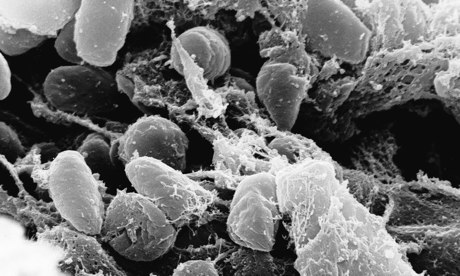Earth Watch Report - Biological Hazards

Image Source : Wikimedia.Org
Author Mikael Häggström

Male Xenopsylla cheopis (oriental rat flea) engorged with blood. This flea is the primary vector of plague in most large plague epidemics in Asia, Africa, and South America. Both male and female fleas can transmit the infection.
Image Source : Wikimedia.Org
Author Centers for Disease Control and Prevention
.....
| Biological Hazard | Madagascar | Sofia Region, Mandritsara |
| Description | |
| A deadly outbreak of the bubonic plague is running rampant on the island of Madagascar, medical experts have confirmed. Tests established the disease was responsible for the deaths of at least 20 villagers in the northwestern town of Mandritsara. The island nation last year recorded the world's highest number of plague-related casualties, with 60 lives claimed by the flea-borne disease. Bubonic plague - also known as the Black Death - wiped out an estimated 25 million people in Europe during the Middle Ages but there have been few instances reported in recent years. Health officials are investigating the cause of the outbreak, thought to have originated in prisons with a prevalence of rats that carry the disease. The Pasteur Institute said towns and cities faced increased risk of infection as ongoing political crises took its toll on living conditions. It is hoped a second round of presidential elections on December 20 will end the political deadlock. | |
| Biohazard name: | Plague (bubonic, human) |
| Biohazard level: | 4/4 Hazardous |
| Biohazard desc.: | Viruses and bacteria that cause severe to fatal disease in humans, and for which vaccines or other treatments are not available, such as Bolivian and Argentine hemorrhagic fevers, H5N1(bird flu), Dengue hemorrhagic fever, Marburg virus, Ebola virus, hantaviruses, Lassa fever, Crimean-Congo hemorrhagic fever, and other hemorrhagic or unidentified diseases. When dealing with biological hazards at this level the use of a Hazmat suit and a self-contained oxygen supply is mandatory. The entrance and exit of a Level Four biolab will contain multiple showers, a vacuum room, an ultraviolet light room, autonomous detection system, and other safety precautions designed to destroy all traces of the biohazard. Multiple airlocks are employed and are electronically secured to prevent both doors opening at the same time. All air and water service going to and coming from a Biosafety Level 4 (P4) lab will undergo similar decontamination procedures to eliminate the possibility of an accidental release. |
| Symptoms: | |
| Status: | confirmed |
The Irish Times
Bubonic plague kills 20 in Madagascar
Confirmation of rodent-born disease follows Red Cross warning that island country is at risk of plague epidemic
 Last year about 60 people died of plague in Madagascar, the highest number globally.
Last year about 60 people died of plague in Madagascar, the highest number globally.
Once feared as the Black Death, the rodent-borne disease that wiped out
one-third of the world’s population in the Middle Ages, bubonic plague
has killed 20 villagers in Madagascar in one of the worst outbreaks
globally in recent years, health experts have confirmed.
The confirmation that bubonic plague was responsible for the deaths
last week near the northwestern town of Mandritsara follows a warning in
October from the International Committee of the Red Cross that the
island nation was at risk of a plague epidemic.
The Pasteur Institute of Madagascar revealed on Tuesday that tests
taken from bodies in the village last week showed they had died of the
bubonic plague. The institute said it was concerned the disease could
spread to towns and cities where living standards have declined since a
coup in 2009.
The deaths are doubly concerning, because the outbreak occurred both
outside the island’s normal plague season, which runs from July to
October, and apparently at a far lower elevation than usual – suggesting
it might be spreading.
Bubonic plague killed 20 villagers in Madagascar, health experts confirm
Announcement of one of worst outbreaks in years raises fears that disease could spread to towns and cities

Bacteria that cause bubonic plague. The disease is spread by Xenopsylla cheopis fleas, whose main host is the black rat. Photograph: Rocky Mountain Laboratories/AP
The confirmation that bubonic plague was responsible for the deaths last week near the north-western town of Mandritsara follows a warning in October from the International Committee of the Red Cross (ICRC) that the island nation was at risk of a plague epidemic.
The Pasteur Institute of Madagascar revealed on Tuesday that tests taken from bodies in the village last week showed that they had died of bubonic plague. The institute added it was concerned the disease could spread to towns and cities where living standards have declined since a coup in 2009.
The deaths are doubly concerning because the outbreak occurred both outside the island's normal plague season, which runs from July to October, and apparently at a far lower elevation than usual – suggesting it might be spreading.
Bubonic plague, which has disappeared from Europe and large parts of the globe, is spread by bites from plague-carrying rat fleas – Xenopsylla cheopis – whose main host is the black rat. In Europe the threat of the Black Death pandemic, which appeared with black rats brought by merchant ships from Asia, eventually died out as black rats were displaced by brown rats and health and hygiene improved.
Read More Here
...








No comments:
Post a Comment
Hello and thank you for visiting my blog. Please share your thoughts and leave a comment :)